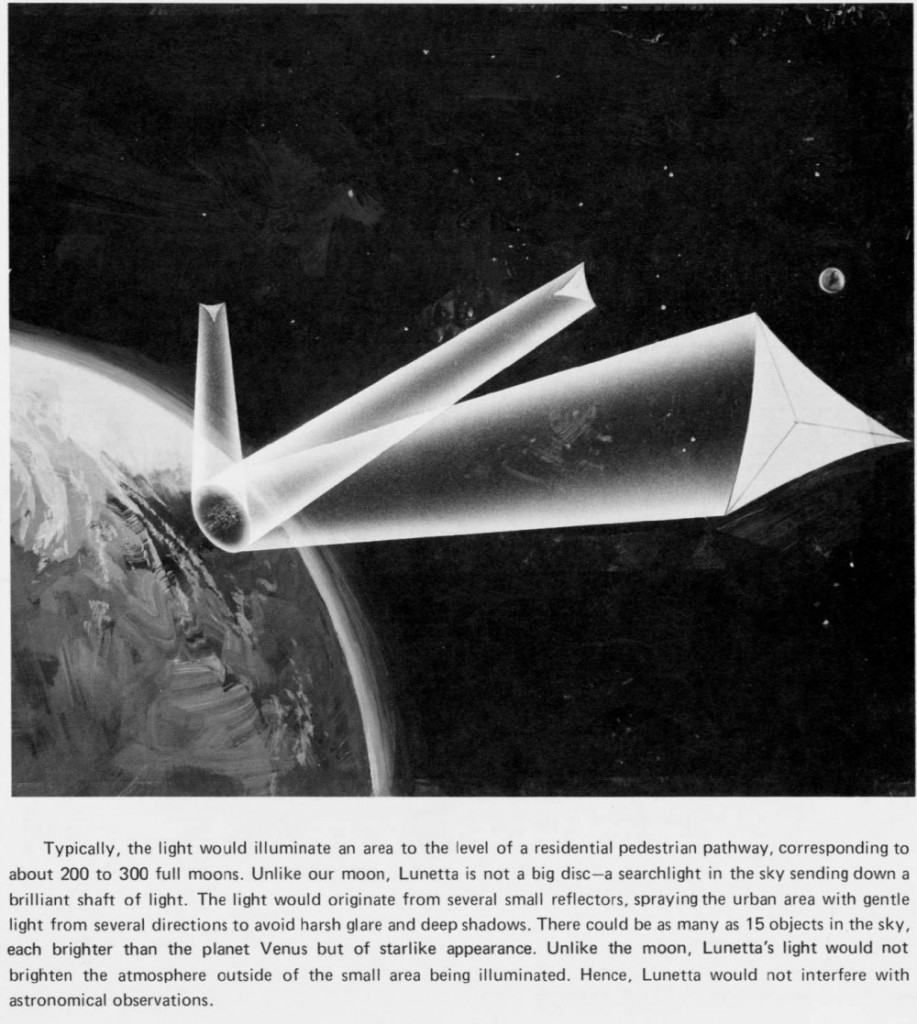The idea of orbital mirrors to shine sunlight down onto the night side of Earth precede WWII; Hermann Oberth proposed such at thing in 1923. Today if someone were to seriously propose an orbiting space mirror the probably use would be to *shade* the Earth from sunlight in order to reduce insolation and very, very slightly cool the planet. Still, it might prove an interesting mathematical study… if an orbiting mirror is used to alternately shade the Earth and then light up the Earth, is it a net positive? When you factor in that the night-time sunlight beamed down would presumably offset artificially generated lighting – say, by lighting up a city, replacing streetlights – it may be that the result would be to reduce planetary temperature.
As recently as 1977, Rockwell International (after Krafft Ehricke) examined the use of orbiting mirrors called “Lunetta” to provide illumination.

“Lunetta” is a weird idea with a no less weird history. A ghost, with some good intentions and bad roots, lurking behind the space race that seems dead from birth and still it does not die.
At first it seemed to be one of many names. Braun picked it up for his first fantastic story at the end of the 20s. The name reappeared somewhere at the end of WWII, when nutzimania went so far as to dream about space stations with “Sun Guns”. Later it made a fast appearance on another Braun’s fantastic story he wrote while waiting for his future in White Sands. Here “Lunetta” plays its darkest role as being part of some shortly described world conflict, where it strangely reminded some space weapon, much as the nazi “Sun Guns”. Some claim that that this story was written together with Ehricke and it seems that he later picked the “Lunetta” name for his own space station projects.
Ehricke’s Lunettas were generically more “optimistic” and lacked a direct relation to anything military, at least on the surface. Besides they were just members of a whole family of “*etta” stations. Anyway, I knew that Krafft Ehricke kept developing these models up to the end of the 60’s. Now it seems he did it deeply into the 70s.
Anyway I cannot forget that Lunneta had quite a dark background in time. And looking at the picture here, it seems it is just a redraw of one made 30 years before…
The WWII-era “sun guns” have always been extremely-poorly documented. But from the limited data available, it’s clear that *someone* didn’t really understand the concept. Either some Germans wholly misunderstood just what you can accomplish with a mirror in the sky (you can brighten the night, but *burning* things? Not a chance), or their interrogators misunderstood… or the press misunderstood what they heard from the Allied interrogators. Also entirely possible: Germans simply *lied* to Allied interrogators. This would not be unlikely; it was important for rocket scientists and the like to play up their usefulness in technical matters. This would not only help them get a job, it would also help keep them out of jail.
The von Braun A-11/A-12 seems to fall into the category. No wartime proof of any real effort on them has come to light, and other Peenemunde rocket scientists have denied that there was any such design. WvB likely dreamed them up while at Ft. Bliss.
Hmmm the real story may be a little more twisted.
Most of what we know on the Sun Gun came from some sort of a press conference that occurred in Paris somewhere at the end of June 1945. References to this “gun” can be seen on July 1945 editions of Time and Life magazines (see References – http://en.wikipedia.org/wiki/Sun_gun). Several newspapers also carried references to this story with a generic tone that nazis “even thought” about such things. At the most, it looked as a public stunt, maybe a test drive to see how the public would react to the hiring of “ex”-nazis if, well, conditions “demanded” such.
Anyway, the “Sun Gun” should have had some pre-history. Apart of being an absurdity in itself (much like the never-dying Silbervogel), some details were clearly very elaborate, ex. the use of Sodium for the mirror or the pumpkin plantations. I wouldn’t be admired if someone finds a direct relationship with Braun’s “Lunetta” of the late 20’s. Yes, the question remains – and how such piece of crap could have lived nearly 15 years and hypnotize a few American officers?! Well, there is nothing extraordinary here! Until the Jutland Battle, British and Germans heavenly believed on the eternal super-powers of the dreadnought fleet. On the eve of WWII, there were “brilliant commanders” in Soviet Union who thought that a good tank was a biiig tank with lots of guns and turrets and considered the T-34 an abomination. And in late 1945 there was a madman in Berlin who constantly thought that he could save his scalp with the help of some “Wunderwaffen”. Meanwhile, let’s not forget that when American and Soviet engineers became acquainted with Silbervogel, they promptly and shortly junked it… And yet there is a good number of idiots that keep the idea alive until our times.
But the most clear historical root for the Sun Gun is probably Oberth. He was the one who first thought about the Space Mirror and the one who influenced Braun to write his story. If I am not mistaken, Oberth kept praying this mirror idea well into the 60s. Some ideas are hard to die.